
The Holy See, also called the See of Rome, is the apostolic episcopal see of the bishop of Rome, known as the Pope, ex cathedra the universal ecclesiastical jurisdiction of the worldwide Catholic Church, and a sovereign entity of international law. Founded in the 1st century by Saints Peter and Paul, by virtue of Petrine and Papal primacy according to Catholic tradition, it is the focal point of full communion for Catholic bishops and Catholics around the world organised in polities of the Latin Church, the 23 Eastern Catholic Churches, and their dioceses and religious institutes.
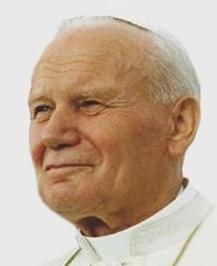
Pope John Paul II was the head of the Catholic Church and sovereign of the Vatican City State from 1978 to 2005.

Pope John XXIII was head of the Catholic Church and sovereign of the Vatican City State from 28 October 1958 to his death in 1963; he was canonized on 27 April 2014. Angelo Giuseppe Roncalli was one of thirteen children born to a family of sharecroppers who lived in a village in Lombardy. He was ordained to the priesthood on 10 August 1904 and served in a number of posts, as nuncio in France and a delegate to Bulgaria, Greece and Turkey. In a consistory on 12 January 1953 Pope Pius XII made Roncalli a cardinal as the Cardinal-Priest of Santa Prisca in addition to naming him as the Patriarch of Venice.
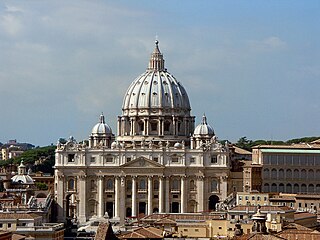
The Second Ecumenical Council of the Vatican, commonly known as the Second Vatican Council or Vatican II, addressed relations between the Catholic Church and the modern world. The council, through the Holy See, was formally opened under the pontificate of Pope John XXIII on 11 October 1962 and was closed under Pope Paul VI on the Solemnity of the Immaculate Conception on 8 December 1965.

Vatican City, officially Vatican City State, is an independent city-state enclaved within Rome, Italy. Established with the Lateran Treaty (1929), it is distinct from yet under "full ownership, exclusive dominion, and sovereign authority and jurisdiction" of the Holy See. With an area of 44 hectares, and a population of about 1,000, it is the smallest state in the world by both area and population.
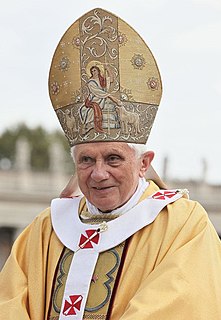
Pope Benedict XVI is a senior prelate of the Catholic Church who served as its head and sovereign of the Vatican City State from 2005 until his resignation in 2013. Benedict's election as pope occurred in the 2005 papal conclave that followed the death of Pope John Paul II. Benedict chose to be known by the title "Pope Emeritus" upon his resignation.

From the Italian unification and as Rome in 1871 became the capital of the new Kingdom of Italy, the Holy See lacked a territory, which it earlier had enjoyed ever since the early Middle Ages. This international-Catholic problem was finally solved through the 1929 Lateran Treaty.
Cases of child sexual abuse by Catholic priests, nuns and members of religious orders in the 20th and 21st centuries have been widespread and have led to many allegations, investigations, trials and convictions as well as revelations about decades of attempts by the Church to cover up reported incidents. The abused include mostly boys but also girls, some as young as three years old, with the majority between the ages of 11 and 14. Criminal cases do not for the most part cover sexual harassment in the workplace against persons who had renounced sexual activity and therefore pre-declined sexual advances. This category includes all priests and seminarians and all religious brothers and sisters. The accusations began to receive isolated, sporadic publicity from the late 1980s. Many of these involved cases in which a figure was accused of decades of abuse; such allegations were frequently made by adults or older youths years after the abuse occurred. Cases have also been brought against members of the Catholic hierarchy who covered up sex abuse allegations and moved abusive priests to other parishes, where abuse continued.
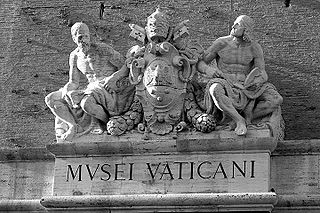
The Vatican Museums are Christian and art museums located within the city boundaries of the Vatican City. They display works from the immense collection amassed by popes throughout the centuries including several of the most renowned Roman sculptures and most important masterpieces of Renaissance art in the world. The museums contain roughly 70,000 works, of which 20,000 are on display, and currently employ 640 people who work in 40 different administrative, scholarly, and restoration departments.

The Vatican Apostolic Library, more commonly known as the Vatican Library or informally as the Vat, is the library of the Holy See, located in Vatican City. Formally established in 1475, although it is much older, it is one of the oldest libraries in the world and contains one of the most significant collections of historical texts. It has 75,000 codices from throughout history, as well as 1.1 million printed books, which include some 8,500 incunabula.

The Secretary of State of His Holiness The Pope, commonly known as the Cardinal Secretary of State, presides over the Holy See Secretariat of State, which is the oldest and most important dicastery of the Roman Curia. The Secretariat of State performs all the political and diplomatic functions of the Holy See and the Vatican City. The Secretary of State is sometimes described as the prime minister of the Holy See, even though the nominal head of government of Vatican City is the President of the Pontifical Commission for Vatican City State.

The Catholic Church, also known as the Roman Catholic Church, is the largest Christian church, with approximately 1.3 billion baptised Catholics worldwide as of 2017. As the world's "oldest continuously functioning international institution", it has played a prominent role in the history and development of Western civilisation. The church is headed by the Bishop of Rome, known as the Pope. Its central administration, the Holy See, is in the Vatican City, an enclave within the city of Rome in Italy.

The lira was the currency of Italy between 1861 and 2002 and of the Albanian Kingdom between 1941 and 1943. Between 1999 and 2002, the Italian lira was officially a national subunit of the euro. However, cash payments could be made in lira only, as euro coins or notes were not yet available. The lira was also the currency of the Napoleonic Kingdom of Italy between 1807 and 1814.

Pope Francis is the head of the Catholic Church and sovereign of the Vatican City State. Francis is the first Jesuit pope, the first from the Americas, the first from the Southern Hemisphere, the first to visit and hold papal mass in the Arabian Peninsula, and the first pope from outside Europe since the Syrian Gregory III, who reigned in the 8th century.
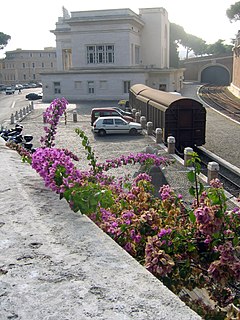
The Vatican Railway was opened in 1934 to serve Vatican City and its only station, Vatican City. The main rail tracks are standard gauge and 300 metres (0.19 mi) long, with two freight sidings, making it the shortest national railway system in the world. Access to the Italian rail network is over a viaduct to Roma San Pietro railway station, and is guaranteed by the Lateran Treaty dating from 1929. The tracks and station were constructed during the reign of Pope Pius XI, shortly after the treaty.

Catholictheology is the understanding of Catholic doctrine or teachings, and results from the studies of theologians. It is based on canonical scripture, and sacred tradition, as interpreted authoritatively by the magisterium of the Catholic Church. This article serves as an introduction to various topics in Catholic theology, with links to where fuller coverage is found.

Crime in the Vatican City consists largely of purse snatching, pick-pocketing and shoplifting by tourists. The tourist foot-traffic in St. Peter's Square is one of the main locations for pickpockets in Vatican City.
Vatican Media is the Holy See national broadcaster of the Vatican City State which first aired in 1983.

The apostolic letter motu proprioPontificalis Domus was issued by Pope Paul VI on 28 March 1968, in the fifth year of his pontificate. It reorganized the Papal Household, which had been known until then as the Papal Court.

Konrad Krajewski is a Polish cardinal of the Catholic Church. He was a papal master of ceremonies from 1998 to 2013. In 2013 he was appointed as the Papal Almoner.
















